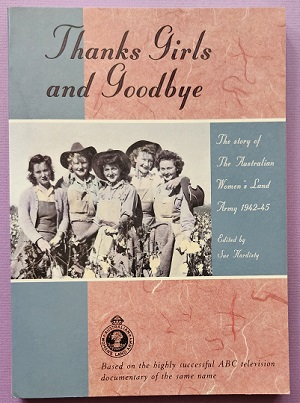Description
Title: Thanks Girls and Goodbye – The Story of the Australian Women’s Land Army 1942-45
Editor: Hardisty, Sue
Condition: Near Mint
Edition: 1st Edition
Publication Date: 1990
ISBN: 0670903566
Cover: Soft Cover without Dust Jacket – 231 pages
Comments: The story of the Australian Women’s Land Army in World War II.
The Australian Women’s Land Army (AWLA) was an organisation created in World War II in Australia to combat rising labour shortages in the farming sector. The AWLA was formed on 27 July 1942 and was modelled on Women’s Land Army in Great Britain. When Japan joined the Axis in 1941 male agricultural labour was recruited into the Australian military to defend the country. To meet the shortfall in rural labour, state and private women’s land organisations began to form under the jurisdiction of the Director General of Manpower. The AWLA disbanded on 31 December 1945. In 1997, many members became eligible for the Civilian Service Medal.
The minimum age for recruits was 18 with a maximum of 50 years of age. Women had to be either be of British origin or immigrants from Allied nations. AWLA women were generally recruited from urban areas and were often unskilled in rural work. The AWLA reached its peak enrolment in December 1943, with 2,382 permanent members and 1,039 auxiliary members. Women in the AWLA worked an average 48-hour week, with pay starting at the AWLA minimum wage of 30 shillings a week. Permanent members were also entitled to sick pay. As was common at the time, Women in the AWLA were paid much less than their male counterparts for the same work. Members of the AWLA covered a variety of agricultural labours, including vegetable and fruit growing, pig and poultry raising, and sheep and wool work.
The AWLA was planned to function in two divisions:
Full-time members: These enrolled for continuous service for 12 months (with the option of renewal); such members were to receive appropriate badges, distinctive dress uniform, working clothes, and equipment.
Auxiliary members: These were available for periods of not less than four weeks at nominated times of the year; such members were to be used for seasonal rural operations, and to receive a badge, working clothes, and essential equipment on loan.





